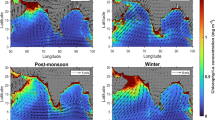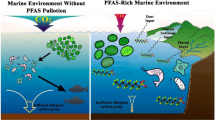Abstract
The sea-to-air flux of dimethylsulphide (DMS) is one of the major sources of marine biogenic aerosol, and can have an important radiative impact on climate, especially in the Arctic Ocean. Satellite-derived aerosol optical depth (AOD) is used as a proxy for aerosol burden which is dominated by biogenic aerosol during summer and autumn. The spring sea ice melt period is a strong source of aerosol precursors in the Arctic. However, high aerosol levels in early spring are likely related to advection of continental pollution from the south (Arctic haze). Higher AOD was generally registered in the southern part of the study region. Sea ice concentration (SIC) and AOD were positively correlated, while cloud cover (CLD) and AOD were negative correlation. The seasonal peaks of SIC and CLD were both one month ahead of the peak in AOD. There is a strong positive correlation between AOD and SIC. Melting ice is positively correlated with chlorophyll a (CHL) almost through March to September, but negatively correlated with AOD in spring and early summer. Elevated spring and early summer AOD most likely were influenced by combination of melting ice and higher spring wind in the region. The peak of DMS flux occurred in spring due to the elevated spring wind and more melting ice. DMS concentration and AOD were positively correlated with melting ice from March to May. Elevated AOD in early autumn was likely related to the emission of biogenic aerosols associated with phytoplankton synthesis of DMS. The DMS flux would increase more than triple by 2100 in the Greenland Sea. The significant increase of biogenic aerosols could offset the warming in the Greenland Sea.
Similar content being viewed by others
References
Andreae M O. 2007. Aerosols before pollution. Science, 315(5808): 50–51
Bailey S W, Werdell P J. 2006. A multi-sensor approach for the on-orbit validation of ocean color satellite data products. Remote Sensing of Environment, 102(1–2): 12–23
Barrie L A. 1995. Arctic aerosols: Composition, sources and transport. In: Delmas R J, ed. Ice Core Studies of Global Biogeochemical Cycles. Berlin, Heidelberg: Springer, 1–22
Charlson R J, Lovelock J E, Andreae M O, et al. 1987. Oceanic phytoplankton, atmospheric sulphur, cloud albedo and climate. Nature, 326(6114): 655–661
Chaves J E, Werdell P J, Proctor C W, et al. 2015. Assessment of ocean color data records from MODIS-Aqua in the western Arctic Ocean. Deep Sea Research Part II: Topical Studies in Oceanography, 118: 32–43
Curry J A. 1995. Interactions among aerosols, clouds, and climate of the Arctic Ocean. Science of the Total Environment, 160–161: 777–791
Curry J A, Rossow W B, Randall D, et al. 1996. Overview of arctic cloud and radiation characteristics. Journal of Climate, 9(8): 1731–1764
Ferek R J, Hobbs P V, Radke L F, et al. 1995. Dimethyl sulfide in the Arctic atmosphere. Journal of Geophysical Research: Atmospheres, 100(D12): 26093–26104
Fitch D T, Moore J K. 2007. Wind speed influence on phytoplankton bloom dynamics in the Southern Ocean Marginal Ice Zone. Journal of Geophysical Research: Oceans, 112(C8): C08006
Gabric A J, Cropp R, Hirst T, et al. 2003. The sensitivity of dimethyl sulfide production to simulated climate change in the Eastern Antarctic Southern Ocean. Tellus B, 55(5): 966–981
Gabric A J, Matrai P A, Vernet M. 1999. Modelling the production and cycling of dimethylsulphide during the vernal bloom in the Barents Sea. Tellus B, 51(5): 919–937
Gabric A, Murray N, Stone L, et al. 1993. Modelling the production of dimethylsulfide during a phytoplankton bloom. Journal of Geophysical Research: Ocean, 98(C12): 22805–22816
Gabric A J, Qu B, Matrai P A, et al. 2005. The simulated response of dimethylsulfide production in the Arctic Ocean to global warming. Tellus B, 57(5): 391–403
Gabric A J, Qu B, Rotstayn L, et al. 2013. Global simulations of the impact on contemporary climate of a perturbation to the sea-toair flux of dimethylsulphide. Australian Meteorology and Oceanographic Journal, 63(3): 365–376
Gabric A J, Simó R, Cropp R A, et al. 2004. Modeling estimates of the global emission of dimethylsulfide under enhanced greenhouse conditions. Global Biogeochemical Cycles, 18(3): GB3016
Hu Ting, Sun Zhaobo, Li Zhaoxin. 2011. Features of aerosol optical depth and its relation to extreme temperatures in China during 1980–2001. Acta Oceanologica Sinica, 30(2): 33–45
Huang Chuanjiang, Qiao Fangli. 2009. The relationship between sea surface temperature anomaly and wind energy input in the Pacific Ocean. Progress in Natural Science, 19(10): 1409–1412
Leck C, Persson C. 1996. Seasonal and short-term variability in dimethyl sulfide, sulfur dioxide and biogenic sulfur and sea salt aerosol particles in the arctic marine boundary layer during summer and autumn. Tellus B, 48(2): 272–299
Levasseur M. 2013. Impact of Arctic meltdown on the microbial cycling of sulphur. Nature Geoscience, 6(9): 691–700
Jones A, Roberts D L, Woodage M J, et al. 2001. Indirect sulphate aerosol forcing in a climate model with an interactive sulphur cycle. Journal of Geophysical Research: Atmospheres, 106(D17): 20293–20310
Meskhidze N, Nenes A. 2010. Effects of ocean ecosystem on marine aerosol-cloud interactions. Advances in Meteorology, 2010: 239808
Nilsson E D, Mårtensson E M, Van Ekeren J S, et al. 2007. Primary marine aerosol emissions: size resolved eddy covariance measurements with estimates of the sea salt and organic carbon fractions. Atmospheric Chemistry and Physics Discussions, 7(5): 13345–13400
Osto M D, Beddows D C S, Tunved P, et al. 2017. Arctic sea ice melt leads to atmospheric new particle formation. Scientific Reports, 7: doi: 10.1038/s41598-017-03328-1
Pang Hao. 2006. Econometrics (in Chinese). Beijing: Science Press
Qu Bo, Gabric A J. 2010. Using genetic algorithms to calibrate a dimethylsulfide production model in the Arctic Ocean. Chinese Journal of Oceanology and Limnology, 28(3): 573–582
Qu Bo, Gabric A J, Lu Hailang, et al. 2014. Spike in phytoplankton biomass in Greenland Sea during 2009 and the correlations among chlorophyll-a, aerosol optical depth and ice cover. Chinese Journal of Oceanology and Limnology, 32(2): 241–254
Qu Bo, Gabric A J, Lu Zhiferng, et al. 2016a. Unusual phytoplankton bloom phenology in the northern Greenland Sea during 2010. Journal of Marine Systems, 164: 144–150, doi: 10.1016/j.jmarsys. 2016.07.011
Qu Bo, Gabric A J, Zeng Meifang, et al. 2016b. Dimethylsulfide model calibration in the Barents Sea using a genetic algorithm and neural network. Environmental Chemistry, 13(2): 413–424
Quinn P K, Bates T. 2011. The case against climate regulation via oceanic phytoplankton sulphur emissions. Nature, 480(7375): 5–16
Quinn P K, Shaw G, Andrews E, et al. 2007. Arctic haze: current trends and knowledge gaps. Tellus B, 59(1): 99–114
Reynolds R W, Rayner N A, Smith T M, et al. 2002. An improved in situ and satellite SST analysis for climate. Journal of Climate, 15(13): 1609–1625
Serreze M C, Walsh J E, Chapin III F S, et al. 2000. Observational evidence of recent change in the northern high-latitude environment. Climatic Change, 46(1–2): 159–207
Simó R, Dachs J. 2002. Global ocean emission of dimethylsulfide predicted from biogeophysical data. Global Biogeochemical Cycles, 16(4): 1078
Spracklen D V, Bonn B, Carslaw K S. 2008. Boreal forests, aerosols and the impacts on clouds and climate. Philosophical Transactions of the Royal Society A: Mathematical, Physical and Engineering Sciences, 366(1885): 4613–4626
Struthers H, Ekman A M L, Glantz P, et al. 2011. The effect of sea ice loss on sea salt aerosol concentrations and the radiative balance in the Arctic. Atmospheric Chemistry and Physics, 11(7): 3459–3477
Zhao Chuanfeng, Garrett T J. 2014. Effects of Arctic haze on surface cloud radiative forcing. Geophysical Research Letters, 42(2): 557–564
Acknowledgements
The authors are grateful to NASA’s Ocean Biology Processing Group for providing MODIS aqua, Level 3 (4-km equi-rectangular projection) 8-day mapped global data for chlorophyll a (CHL) and aerosol optical depth (AOD). We thank the NASA Web Sea- DAS development group for providing ocean colour SeaDAS Software (SeaWiFS Data Analysis System) for processing regional CHL and AOD data. Thanks to NOAA NCEP EMC CMB GLOBAL Reyn-SmithOIv2 for providing weekly and monthly sea-ice concentration. Thanks to the NASA Earth Science MEaSUREs DISCOVER Project and the NASA Earth Science Physical Oceanography Program for providing Wind Data and Sea Surface Temperature data and NASA for providing cloud cover data (http://gdata1.sci.gsfc.nasa.gov). Thanks to Ren Hongjian from School of Computer Science and Technology in Nantong University for helping with the wind data.
Author information
Authors and Affiliations
Corresponding author
Additional information
Foundation item: The National Natural Science Foundation of China under contract No. 41276097.
Rights and permissions
About this article
Cite this article
Qu, B., Gabric, A.J., Zhao, L. et al. The relationships among aerosol optical depth, ice, phytoplankton and dimethylsulfide and the implication for future climate in the Greenland Sea. Acta Oceanol. Sin. 37, 13–21 (2018). https://doi.org/10.1007/s13131-018-1210-8
Received:
Accepted:
Published:
Issue Date:
DOI: https://doi.org/10.1007/s13131-018-1210-8




